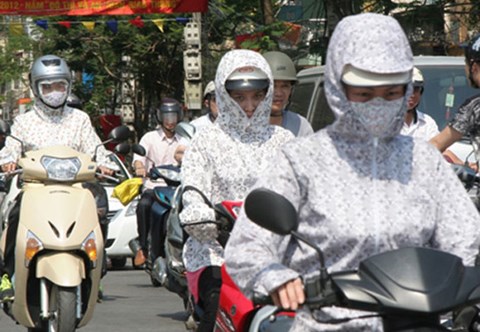Feel the burn: Experts warn of more deadly heat waves for Viet Nam
Hot weather is threatening to claim more lives according to a new study that forecasts dramatic temperature rises in Viet Nam and across the world by the end of the century.
 |
| (Photo:anninhthudo.vn) |
The study published in Nature Climate Change said that nearly a third of people around the world are currently exposed to deadly heat waves, and the rate will rise to nearly half of the global population by 2100 even if drastic efforts are made to cut emissions.
If emissions continue to rise at their current pace, 3 in 4 people in the world will face ‘deadly heat’ by then, it said.
The study included maps of the number of days per year when heat waves burn above a deadly threshold, and paints risky colors for Viet Nam and many countries in Asia-Pacific, Africa and South America.
Data collected between 1995 and 2005 puts Viet Nam among a small number of country's where the number of deadly hot days reached 50 or more a year.
The study projects three scenarios for heat waves between 2090 and 2100, depending on different levels of greenhouse gas emissions.
In any case, the situation will not improve, and in the worst case scenario, deadly hot days will burn most of Viet Nam for between 200 and 250 days a year by 2100. The central and southern regions will be worst hit.
“People are talking about the future when it comes to climate change, but what we found from this paper is that this is already happening … and this is obviously going to get a lot worse,” Camilo Mora, lead author of the study and a geography professor at the University of Hawaii at Manoa, said in a statement, as quoted by Reuters.
“We are running out of good choices for the future,” he warned. “For heat waves, our options are now between bad or terrible.”
People are already experiencing bad heat waves when heat and humidity exceed a person’s core body temperature – about 37 degrees Celsius, or 98.6 degrees Fahrenheit, which makes it hard for people to dissipate heat, the researchers said.
The most serious risks will be in tropical areas, where heat can last most of the year rather than just during the summer, they said.
Iain Caldwell, a co-author of the report and a researcher at the University of Hawaii at Manoa, said in the statement that with temperatures already high, “it takes very little warming for conditions to turn deadly in the tropics”.
But other parts of the world will also be in danger.
By 2100, for instance, New York is likely to experience around 50 days a year with combined temperature and humidity exceeding the threshold at which people have previously died, researchers said.
Strong heat is already causing more stroke-related deaths and hindering productivity in many countries.
The University of Hawaii study, which looked at 164 cities across 36 countries, looked at nearly 2,000 deadly heat waves since 1980, including a European heat wave in 2003 linked to 70,000 deaths, a 2010 Moscow heat wave that killed about 10,000 people and a 1995 Chicago heat wave that claimed 700.
(Source: VnExpress International)